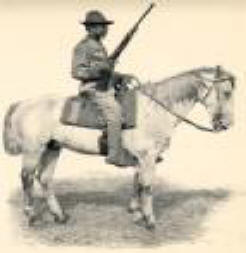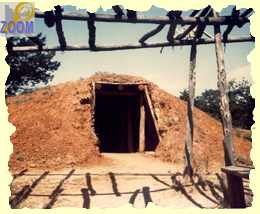|
|
|
|
|
|
|
They
say they came from the southwest or south to their Great Plains homes long
before living memory. Evidence says that the Pawnees resided in the
Central Plains region for centuries before the historical period. The
Pawnees lived in elevated river terraces and bluff sites along fifty-mile
stretch of the Loup and Platte Rivers. There they gathered wild foods,
grew squash, pumpkins, beans, and corn. They also hunted buffalo on
annual hunts. |
|
|
|
|
|
Pawnee
hunters first saw horses in the late seventeenth or early eighteenth
centuries. When settlers came from Europe, they began trading and giving
gifts to the Indians for land to make North America bigger. The Pawnee
leaders met with major U.S. leaders and began so called treaties and
agreements that eventually ended up with Pawnee tribes on reservations.
To escape these reservations the warriors joined the United States army as
scouts. They fought against their enemies, the Sioux and the Cheyenne in
the 1860s and 1870s. In 1857 the reservations got so crowded bands or
tribes had to unite. They had a head chief, sub chiefs, leading warriors
, and religious leaders. Marriage occurred between village members, and
men then lived in their wives household. |

|
|
|
|
|
Early
in the nineteenth century population estimates ranged from ten to twelve
thousand. By 1900, warfare, disease, and devastating conditions brought
their number down to six hundred. Several losses generated cultural
changes in leadership structure, residence patterns, and religious
practices. The significance of Pawnee life attracted the attention of
many scholars. Religious beliefs permeated most aspects of life.
The Buffalo, Deer, Bear, Pipe, and Doctor Dances, in which feats of magic and
curing procedures astounded the observers. Today, only the Kitkahahki
War Dance and the Young Dog Dance are practiced, intermittently, as are hand
games, Christmas, Memorial Day, and family-sponsored dances utilizing
traditional clothing, rituals, and songs. |
|
|
|
|
|
The Pawnees tried unsuccessfully to resist government reservation land
allotment in 1887 and the surplus reservation-land sale in 1892.
Demoralized and frustrated, the Pawnees accepted the Ghost Dance and the
sacramental use of peyote in the ongoing Native American Church.
Christianity became the Pawnees religion as older traditions began to
fade. Today, only two Pawnee events are the annual summer visits between
the tribe and the Wichitas, their Caddoan linguistic Kinsmen, and four-day
July Pawnee Homecoming, sponsored by the well-respected Pawnee Veterans’
Association. Tribal members from all over the states return to Pawnee,
Oklahoma, to visit relatives, camp, and take part in craft shows and evening
powwows. The home-coming is a focal point for continuing tribal
practices and identity. Institutionalized education began with the
arrival of Christian missionaries among the Pawnees in the 1820s. Later,
school policies on the reservations often forced children to leave their home
for long periods of time to attend schools where they lost their native
language when they were prevented from speaking it. With this loss, the
culture and oral history expressed in stories, songs, and ritual began to
slowly disappear. Today only a few dedicated elderly speak Pawnee
fluently. |
|
|
The
Way They Were Remembered |
|
|
The Pawnees are well remembered for their
ability to raid neighboring tribes and acquire their horses, especially, from
the tribes to the southwest and to the south.
The horses gave them a way to travel that gave them a name to be feared
by their enemies. The government did
not give them any extra privileges for being a “friendly nation”. They gave the warring tribes gifts,
sometimes consisted of rifles to hunt buffalo. These same rifles were used against the Pawnees. The warriors
were men of great endurance and courage. Even when outnumbered and out
armed they often won battles. Some of
their defeats were considered legendary.
|
|
|
|
|
|
One leader, Chief Crooked Hand of the Skidi
Band, arose from bed to muster the old men, women, and boys to command a
charge to defend their home. They
fought off an enemy even though they were outnumbered two to one. |
|
|
|
|
|
Pawnees dressed just like other plains
tribes. However, the Pawnees had a special
preparation for their hair by dressing a scalp lock with buffalo fat until it
stood up and curved backward like a horn. In
1833, 1848, 1857, and 1872 the Pawnees unwillingly gave up their lands to the
United States Government. They went
to Oklahoma from Nebraska. The Pawnee
Indian Agency was established just to the East of the present site of Pawnee,
Oklahoma. The boarding school on the
reservation for the Pawnee children was closed in 1958 and the land was given
back to the tribe in 1968. Many of
the buildings were renovated and are now used for office buildings. |
|
|
|
|
|
Today the tribal enrollment is about 2,500
members. Pawnees can be found in many
walks of life in all areas of the United States of America as well as in other
countries around the world.
Pawnees take much pride in their ancestral heritage. They are noted in history for their tribal
religion, rich in myth, symbolism and elaborate rites. |
|
|
Some Pawnee Background |
|
|
By the 1830s the Pawnees were well established in
present-day Nebraska and numbered about 12,000. They had a very loose social-political organization. Chiefs only had persuasion. The Pawnees were split up into two major
groups, the Skidis and the southern bands.
The groups consisted of villages and houses. Members of a village considered themselves “kin”. Chiefs were actually considered household
officials rather than government officials.
A household usually consisted of thirty to fifty members living in a
dome-shaped structure roofed with earth.
Generally two heads of households shared each lodge. One overlooked
the northern sector and the other overlooked the southern sector. Each sector was then divided into three
stations into which the women were divided.
One station was for the mature women, who did most of the labor. A second station was for the young single
women who were just learning their responsibilities. The third and last station was for the
older women who cared for the young children and babies as well as other
household matters. |

|
|
|
|
|
Twice a year the members went on a semi-annual
buffalo hunt. The units broke down
into smaller groups, headed by an able hunter. Once the hunt was over they returned to the villages. They often did not go back to the same
household as before. The internal structure stayed the same. Young men congregated at different
households. When they married they
moved in with their wives. Older men
moved freely. Marriage of the
outsiders or blood related was not supported. In fact blood related was
prohibited. The Pawnees depended on
the corn and buffalo. The Pawnees
tied religious ceremonies to the corn’s planting, hoeing, and
harvesting. The Pawnee lifestyle
alternated between planting crops and hunting. After tending to their crops they left in mid-June for a
buffalo hunt. In September they
returned to harvest their crops.
After storing their foodstuffs they left in October for their winter
buffalo hunt. In April they returned
to start the cycle all over again.
During the hunts they lived in tipis.
Pawnees had ceded the last of their land in Nebraska, and became U.S.
citizens in 1892. At that time they
had a population that dropped dramatically to about 800. After reaching a low in 1906 to about 649,
the Pawnee Indian population has been gradually increasing, exceeding 1,000
in 1940. The Pawnee Indians have
survived a long time and are very proud of their ancestors. The Pawnee Indians have lived in many
different parts of the country. They
have mostly lived in Kansas, Oklahoma, Nebraska, and Texas. The Pawnee Indians have tried to be a
friend to the U.S., but how can they when they just stab you in the
back. |
|
| Bibliography: | |
| Houghton Mifflin, Pawnee, Http://www.college.hmco.com/history/readerscomp/naind/html/na_028300_pawnee.htm 5-9-05 | |
| The Brown Quarterly, Kansas Tribes: Past and Present, http://www.brownvboard.org/brwnqurt/05-2/05-2c.htm 5-9-05 | |
| Red River Authority of Texas, Pawnee Indians, http://www.rra.dst.tx.us/c_t/indians/PAWNEE%20INDIANS.cfm 5-9-05 | |
|
Images: |
|
| Kansas Secretary of State, Kansas Landscape Archives, http://www.kssos.org/about/about_ks_archive.html 5-13-05 | |
| Indian City USA Indian Villages, Pawnee Village, http://www.indiancityusa.com/indian_village_pawnee.asp 5-13-05 | |
|
Music: |
|
|
MIDI Database, Movie Themes, http://themes.mididb.com/movies/ 5-17-05 |
|
|
Robert Cooper
8th American History 2005 Project |
|

